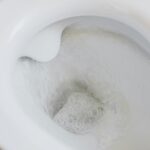Noticing water backing up into your shower can be frustrating and often indicates a plumbing issue you can’t afford to ignore. It might stem from something as simple as a clogged drain or a more complex problem like sewer line backups. Understanding the cause is crucial to prevent further damage. Let’s explore what could be causing this inconvenience and how you can address it effectively.
Common Causes of Shower Water Backup
Water backing up into your shower can be a frustrating experience, and several common causes might be to blame.
One likely culprit is hair accumulation in the drain, which can trap water and prevent proper drainage.
Another issue could be soap scum buildup, creating a barrier that slows down water flow.
Additionally, any foreign objects that accidentally fall into the drain can obstruct it, leading to backups.
You might also face problems related to improper plumbing, like a venting issue that disrupts water flow.
Lastly, tree roots invading your sewer line can cause serious obstructions that back up water.
Identifying these causes early can save you from more significant plumbing issues down the road.
Clogged Drains: A Deep Dive
While you mightn’t think about it often, clogged drains can lead to significant issues in your home, especially in the shower. When hair, soap residue, and other debris accumulate, they create blockages that prevent water from flowing freely.
This can result in slow drainage or even backups, leaving you standing in a puddle. Regular maintenance is key; consider using a drain cover to catch hair and debris.
If you notice water pooling, act quickly. You can use a plunger or a plumber’s snake to dislodge minor clogs. For tougher blockages, a mixture of baking soda and vinegar can help break down buildup.
Staying proactive ensures your shower remains a relaxing space rather than a source of frustration.
Issues With the P-Trap
Clogged drains aren’t the only reason you might experience water backing up into your shower. Issues with the P-trap can also be a culprit.
The P-trap is that curved pipe beneath your shower that traps water and prevents sewer gases from entering your home. If it becomes clogged with hair, soap scum, or debris, water can’t flow freely, causing backups.
You might also face problems if the P-trap is improperly installed or damaged. Regularly checking and cleaning the P-trap can help prevent these issues.
If you notice persistent backups despite cleaning, it’s wise to consult a plumber. They can assess the situation and ensure your plumbing system functions smoothly, keeping your shower water where it belongs—draining away!
Problems With Ventilation
If your shower’s ventilation system isn’t functioning properly, it can lead to water backing up and creating a frustrating experience.
Poor ventilation can increase humidity levels, making it harder for water to drain effectively. When air can’t flow freely, it can cause negative pressure in your plumbing, leading to slow drainage and backups. You may notice unpleasant odors or mold growth as a result.
To fix this, check your vent fan to ensure it’s working and clear of obstructions. Regular maintenance, like cleaning the fan and ducts, can improve airflow.
If you’re still having issues, consider consulting a professional to evaluate the entire ventilation system. Addressing these problems promptly can help keep your shower functioning smoothly.
Sewer Line Backups
Sewer line backups can be a major headache, especially when they cause water to flow back into your shower. When this happens, it usually indicates a blockage somewhere in your sewer system. Common culprits include tree roots, grease buildup, or foreign objects.
Ignoring the issue can lead to more extensive damage and costly repairs. You might notice foul odors or gurgling sounds coming from your drains as well. If you experience these symptoms, it’s crucial to act quickly.
Consider using a plunger or a plumbing snake for minor clogs, but don’t hesitate to call a professional plumber if the problem persists. Regular maintenance, like scheduling sewer cleanings, can help prevent future backups and keep your plumbing system running smoothly.
Plumbing System Design Flaws
When water backs up into your shower, it can be more than just a pesky issue; it might also highlight underlying plumbing system design flaws.
Often, these flaws stem from improper slope in drain lines, which can prevent water from flowing smoothly. You might also encounter issues with pipe diameter; if pipes are too narrow for the volume of water, clogs can occur more easily.
Additionally, inadequate venting can lead to pressure differences that cause slow drainage. If you’ve noticed recurring backups, take a closer look at your plumbing design.
A professional plumber can assess whether design adjustments are necessary to improve water flow and prevent frustrating backups in the future. Investing now can save you headaches later.
Signs of a More Serious Issue
While occasional backups might seem like a minor annoyance, they could signal a more serious plumbing issue lurking beneath the surface.
If you notice frequent backups or gurgling sounds in your shower, it’s time to pay attention. These signs often indicate a clogged drain or a backup in the main sewer line.
Additionally, if water drains slowly or rises in other fixtures, it’s a clear warning that your plumbing system may be compromised. Unpleasant odors or recurring leaks can also hint at underlying problems that need immediate attention.
Ignoring these signs can lead to more extensive damage and costly repairs. Don’t hesitate to call a professional plumber if you suspect a more serious issue at play.
DIY Solutions for Minor Clogs
If you’re dealing with minor clogs in your shower, you can often tackle the issue yourself before calling in a plumber.
Start by removing the drain cover and clearing any hair or debris you can see. A plunger can work wonders; make sure there’s enough water in the shower to cover the cup, and give it a few strong pumps.
You might also try a mixture of baking soda and vinegar. Pour half a cup of baking soda down the drain, followed by half a cup of vinegar. Wait 15 minutes, then flush with hot water.
If these methods don’t clear the clog, consider using a plumber’s snake to reach deeper blockages.
These simple steps can save you time and money!
When to Call a Professional Plumber
How can you tell when it’s time to call in a professional plumber? If your shower’s water backs up frequently, it’s a sign of a bigger issue.
When DIY methods fail to clear the clog or if you notice water pooling not just in the shower but in other areas of your home, don’t hesitate to reach out for help.
Additionally, if you smell foul odors or see signs of leaks, these could indicate serious plumbing problems.
Persistent slow drainage or unusual gurgling sounds from your pipes also warrant a call.
Conclusion
If you’re experiencing water backing up into your shower, don’t ignore it! Whether it’s a simple clog or a more serious plumbing issue, addressing the problem early can save you time and money. Start with some DIY solutions for minor clogs, but remember, if the problem persists, it’s best to call a professional plumber. They can diagnose the underlying issues and ensure your plumbing system runs smoothly. Keep your showers enjoyable and hassle-free!


